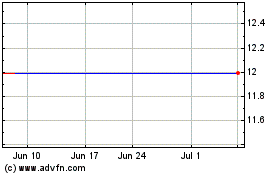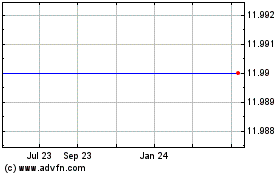Time Coming For Commercial Mortgage Market To Stand On Its Own
March 18 2010 - 4:38PM
Dow Jones News
The Federal Reserve on Friday will conduct the last round of
purchases of existing commercial mortgages, marking the end of a
government program designed to buoy markets and boost investor
confidence in securities that have been battered since the
financial crisis in 2008.
The end of this part of the Term Asset-Backed Securities Loan
Facility, or TALF, leaves a corner of the commercial mortgage
market on its own, and investors won't see new deals until later in
the year, when regulators are expected to provide more clarity on
securitization.
While the Fed's role has been small relative to other
programs--the central bank has granted only $11 billion in loan
requests since last June--the impact has been much larger in a
sector still in the throes of a painful correction.
"TALF provided psychological support for the market," said
Darrell Wheeler, head of commercial mortgages at Amherst
Securities. "It served its purpose at the time it was needed."
TALF initially was set up to restart the issuance of
asset-backed securities. The Fed extended it to both new and old
commercial mortgages at the behest of the industry, which was
grappling with frozen markets in 2008 and early 2009. The bleak
outlook and a lack of capital and deals prompted the sector to seek
succor from the central bank. The continued lack of activity and
rising concerns about the impact of unemployment on retail and
office properties late summer last year prompted the Fed to extend
the program.
Investors say the market has thawed appreciably after the
government started to buy these instruments under TALF, helping to
reduce risk premiums in the secondary market. The easing of risk
encouraged issuers to offer the first commercial mortgage bond in
more than 18 months last November from Developers Diversified
Realty.
Under the aegis of TALF, that deal was oversubscribed and two
additional deals were offered in quick succession to tap the
residual investor interest.
There has been little else since then, but investor attitudes
have brightened since the dark days of spring 2009 and there is
more confidence that the $770 billion market will be able to
recover on its own.
Still, one question may yet delay new CMBS deals: That is the
matter of whether issuers need to retain a stake in the deal,
Wheeler said. In the past there was no requirement do so, prompting
criticism that the lack of a stake in a deal encouraged banks to
sell deals they wouldn't hold in their own portofolios.
"This lack of clarity is limiting loan origination to the
largest banks who have the capacity to hold these loans on balance
sheets if they can't securitize them," Wheeler said.
Sentiment in the secondary market where exisiting deals are
traded is better, though much of the confidence stems from lower
prices. Even though the oulook for the sector remains dim with
rising delinquencies and falling property prices, interest from
both traditional and non-traditional investors has ramped up.
Many see these bonds, with built-in cushions to protect
investors in the event of default, are seen as safer investment
options. They also are attractive given that their prices are much
cheaper than comparable assets in other classes, and with yields on
top-rated bonds between 7% and 12%.
Roger Bayston, a senior vice president at Franklin Templeton
Fixed Income, said his company continues to hold commercial
mortgages.
He added that price dislocations in the market opened up buying
opportunities, especially among lower-rated tranches.
While TALF helped jumpstart consumer-related asset-backed
issuance, additional complexities of pooling commercial loans, the
longer terms of those loans, and the continued deterioration of the
fundamentals backing those loans, made the program much less
effective, Bayston said.
"TALF is no longer a big factor, and doesn't have much influence
in new issue CMBS," he said.
So it's unlikely that there will be another request to extend
the program for new issues beyond the June deadline.
"Six months ago, it was important to extend the deadline on TALF
for new issues. Now the market has moved on," Wheeler said.
-By Prabha Natarajan, Dow Jones Newswires; 212-416-2468;
prabha.natarajan@dowjones.com
Developers Realty (NYSE:DDR)
Historical Stock Chart
From May 2024 to Jun 2024

Developers Realty (NYSE:DDR)
Historical Stock Chart
From Jun 2023 to Jun 2024
